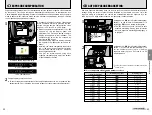
56
57
Advanced
Photography
3
This is a photography technique that allows you overlay photographed images on top of each
other. You can use this technique to compose shots that cannot be obtained normally.
3
Compose picture, focus and shoot. A bracketing bar graph in the top display panel shows
the photography status each time a shot is taken.
h
When three shots are to be taken, “
” is shown before shooting begins, “
”
appears after the first shot, “
” appears after the second shot, and the bar graph
disappears when shooting is completed.
h
If you hold the shutter button down when the “
r
” (Continuous shooting) release mode is
selected, shooting automatically stops when the specified number of shots has been
taken. Note that shots are taken one frame at a time when the built-in flash is used.
h
If the exposure compensation function (
➡
P.54) or flash exposure compensation (
➡
P.67)
is also set, Bracketing will be combined with the exposure compensation values. It is
useful to perform Bracketing with a compensated value of over +2 EV or under –2 EV.
h
To cancel the Bracketing, rotate the Main-Command Dial while pressing the “
q
” button
so “
Q
” disappears from the top display panel or perform Two-Button Reset (
➡
P.95). The
number of shots and compensated EV values previously selected will remain when they
are cancelled with the Main-Command Dial, and they automatically reset to “
”
when the Two-Button Reset is performed.
CSM
1: Bracketing order can be set to change from negative EV value to positive EV value
(
➡
P.97).
1
Hold down the release mode switch unlock
button and set the release mode switch to “
i
”
(multi-exposure). When you select multi-
exposure mode, the “
i
” icon appears in the
viewfinder display.
2
According to the photography conditions, hold
down the “
u
” (exposure compensation) button
1
as you turn the main command dial
2
to set
the exposure offset.
◆
Standard compensation value in Multiple exposure
◆
0
1
0
2
q
AUTO EXPOSURE BRACKETING
i
MULTIPLE EXPOSURE
Continued over page...
In multi-exposure, a number of images are shot in the same frame. When you are overlaying
backgrounds and subjects, you must set the appropriate exposure offset before taking any shots.
h
Test shooting is recommended since the
compensation actually required varies
depending on the shooting situation.
h
When the background is completely dark and
subjects do not overlap, no compensation is
necessary for each shot.
■
General guide to exposure offsets
Number of exposures
Compensation value
Two
Three
Four
Summary of Contents for FinePix S2 Pro
Page 64: ......
















































